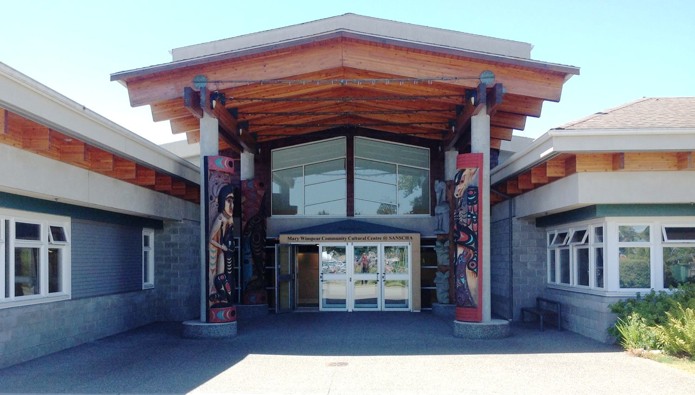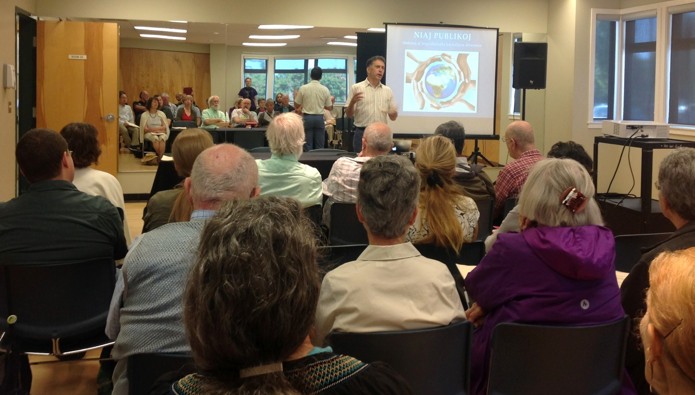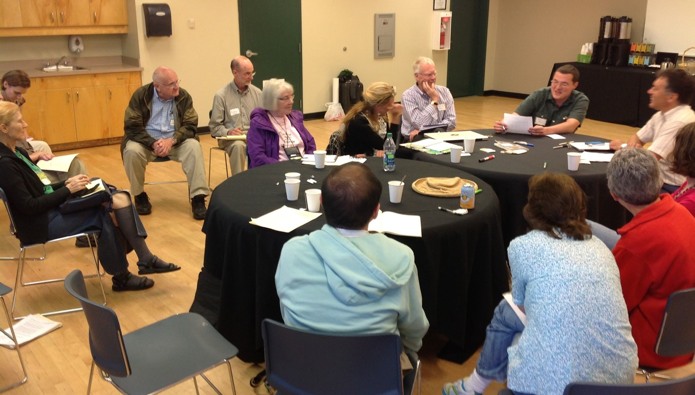
On 9 and 10 July 2014, thirty or so activists from Canada and the United States, plus visitors from China, Japan and Taiwan, and I from Australia, participated in a two-day seminar for activist development (“AMO-2”) in the coastal town of Sidney (British Columbia, Canada). The seminar addressed the theme “The strategy and practice of Esperanto promotion in North America”, under the guidance of Dr Mark Fettes, president of UEA.

The Mary Winspear Center, Sidney BC, the seminar venue
– development of technical resources
– the use of social networks
– responses to FAQs, and
– creating a framework for further efforts towards sustainable development.
Each group aims to build upon ideas and discussions from the seminar, to prepare concrete recommendations and information resources over the coming months.
In the opening plenary, Fettes pointed out that information is more effective when it touches the feelings and emotions of people. Although one should not neglect rational arguments for Esperanto, a priority is the communication of core values – for example, that Esperantists are open, inclusive, inquisitive, educated, and with a high sense of personal responsibility. According to him, promotion of Esperanto should clearly show that Esperantists are multilingual and diverse people, who in turn understand and love human diversity.

Dr Mark Fettes presents the opening plenary
A workshop on being interviewed by journalists led to an additional one on how to answer the most “ticklish” questions about Esperanto. In parallel were workshops about social networking and the creation of audiovisual information materials, such as videos.

One of the workshops
It became clear that we do not know enough about the backgrounds, motives, interests and abilities of those who are interested in Esperanto. Thus was born a project to survey several groups – such as association members, people seeking information about the language, lernu-users and NASK students – and to collect and analyse such information. With the support of the governing bodies of Esperanto-USA and the Canadian Esperanto Association, and specialist advice from Ĵenja Amis (a Master’s student in marketing), a small team will realise this project in the coming months. If it turns out to be useful, it could be a model for other national associations, such as our own (AEA).
Many interesting and useful pieces of advice were discussed. I hope to follow this report with more detailed notes, but in the meantime, amongst the pieces of advice from the seminar were the following (regarding contact with journalists, in interviews, media releases and articles):
– Find a concrete anchor or hook, e.g. an anecdote or quotation about a particular person, event or achievement.
– Avoid too many internal terms, abbreviations and esperantisms (e.g. “congress” and “Esperantist” – better would be a “conference” and “Esperanto speaker”).
– Pay attention to local culture and the ways that certain words and concepts are interpreted, such as “international”, “planned”, “constructed”, “artificial”, “universal” and “neutral”.
– Do not invent ”facts” in an interview. If you don’t know an answer, say so, and say something that you actually do know. Obviously, however, the more you know, the better!
Jonathan Cooper
[I would like to thank Dr Mark Fettes for his permission to use parts of his own report as a basis for my own.]
